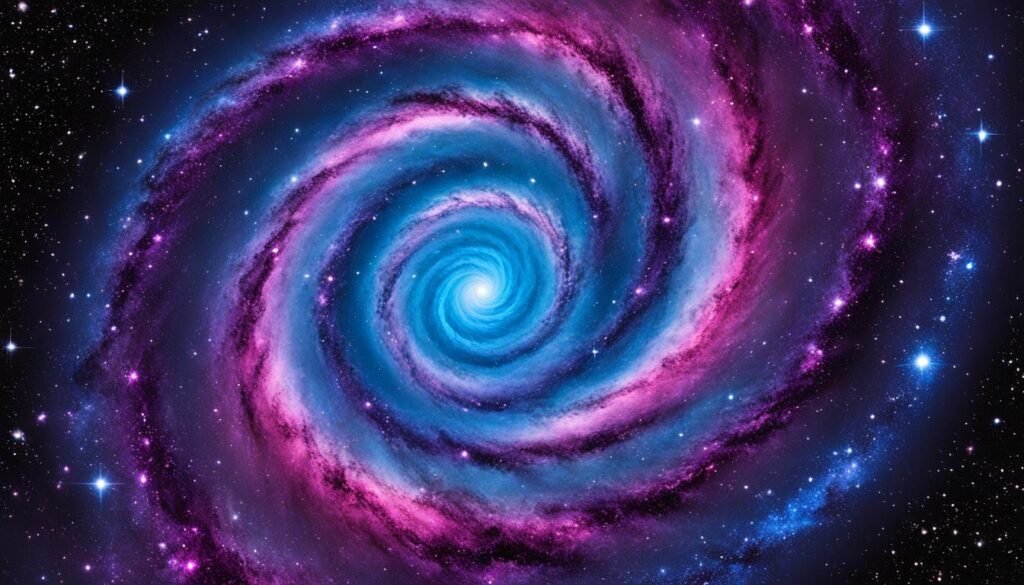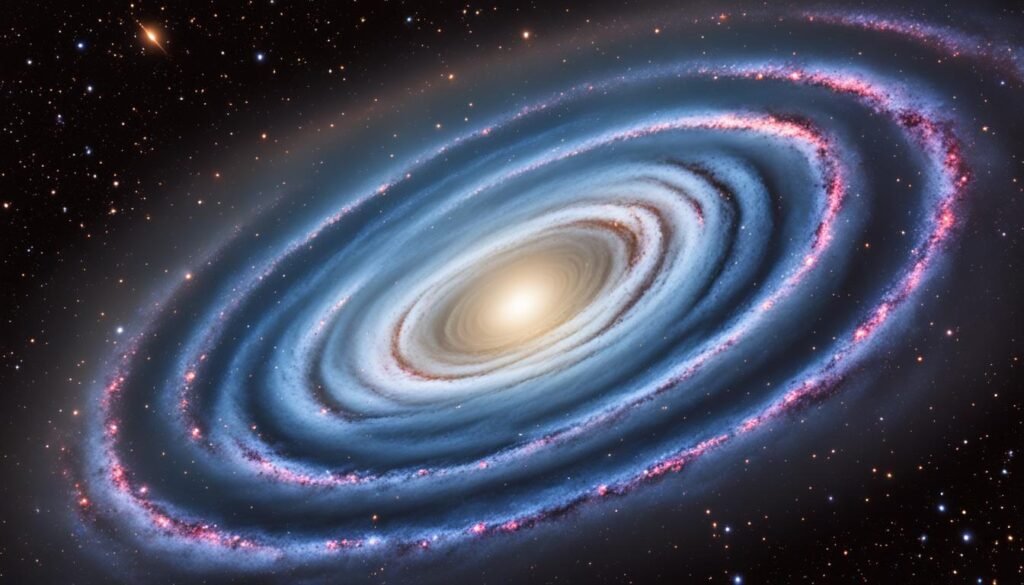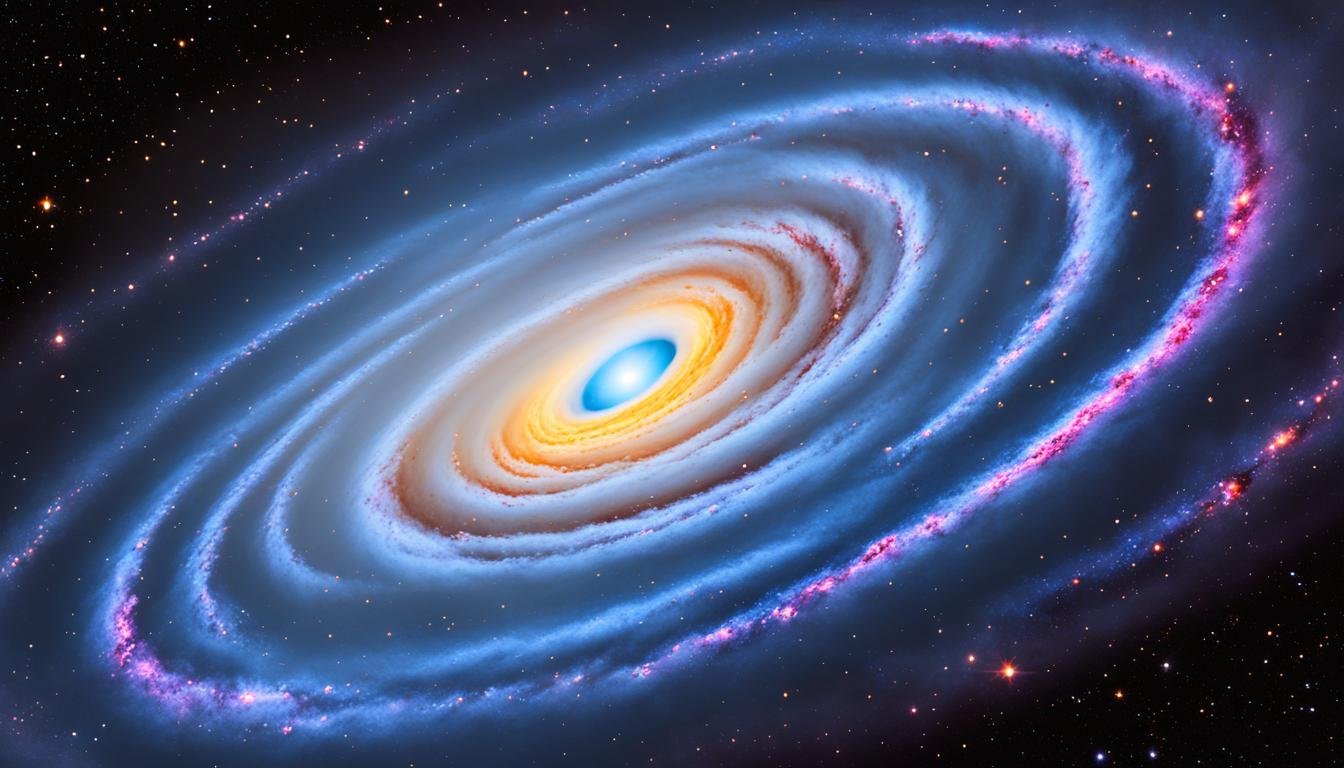Have you ever gazed up at the starry night sky and wondered about the secrets it holds? If you’re fascinated by astronomy and the mysteries of deep space, then Messier 77 Cetus A is a celestial body that deserves your attention. Situated in the constellation Cetus, Messier 77 is a breathtaking spiral galaxy that has captivated astronomers and astrophotographers alike.
The remarkable structure of Messier 77, with its spiral arms and bright core, makes it a standout deep sky object. This stunning galaxy, located approximately 47 million light-years away from Earth, offers a wealth of opportunities for astronomical observation and astrophotography.
The classification of Messier 77 as a spiral galaxy further enhances its allure. Its grand design and intricate features make it a fascinating subject for scientific exploration and study. Understanding the qualities and characteristics of this magnificent celestial body elevates our knowledge of galaxy classification and contributes to the broader understanding of the universe.
Join us as we embark on a journey through the depths of space to discover the secrets of Messier 77 Cetus A. From its location and defining characteristics to its active galactic nucleus and noteworthy scientific discoveries, we’ll uncover the wonders that await those who study and observe this captivating spiral galaxy.
Key Takeaways:
- Messier 77 Cetus A is a spiral galaxy located in the constellation Cetus, approximately 47 million light-years away from Earth.
- Its distinctive spiral arms and bright core make it a popular subject for astronomical observation and astrophotography.
- The active galactic nucleus of Messier 77 is obscured from view by astronomical dust but has been studied using radio wavelengths.
- Messier 77 has been the site of a supernova and the detection of neutrinos emitted by its active galactic nucleus, providing valuable insights into astrophysical processes.
- Observing and photographing Messier 77 can be done with telescopes and astrophotography equipment, revealing its unique structure and fascinating details.
Location and Characteristics of Messier 77
Messier 77, also known as Cetus A, is a celestial body located in the constellation Cetus. It is positioned at coordinates 02h 42m 40.7s, −00° 00′ 48″. With an apparent magnitude of 8.9, Messier 77 is visible in the night sky, approximately 47 million light-years away from Earth.
This galaxy, classified as (R)SA(rs)b, exhibits the characteristics of a barred spiral structure with moderately wound spiral arms. Its apparent size measures 7.1′ × 6.0′, and it boasts a mass estimated to be around 1×10^9 solar masses. Moreover, Messier 77 is renowned as one of the largest galaxies featured in Messier’s catalog, captivating observers with its captivating attributes.
By studying Messier 77, astronomers gain valuable insights into the structure and nature of celestial bodies, furthering our knowledge of the galaxy classification and fueling future discoveries.
The Active Galactic Nucleus (AGN) of Messier 77
Messier 77, also known as Cetus A, is not just an ordinary celestial body. This spiral galaxy holds a fascinating secret at its core – an active galactic nucleus (AGN). The AGN of Messier 77 sets it apart from other galaxies and makes it an intriguing target for astronomical observation.
The AGN of Messier 77 is concealed from direct observation by a veil of astronomical dust, rendering it invisible at visible wavelengths. However, astronomers have utilized radio wavelengths to peer through this cosmic shroud and uncover the hidden mysteries within.
| Feature | Description |
|---|---|
| Molecular Disk | A radio wavelength observation of Messier 77 revealed the presence of a molecular disk surrounding the AGN. This disk is composed of gas and dust, which play a crucial role in fueling the activity within the nucleus. |
| Hot Plasma | The presence of hot plasma has also been detected around the AGN. This high-energy plasma is associated with the obscuring material and provides further evidence of the intense processes occurring within Messier 77. |
The AGN in Messier 77 is not only noteworthy for its hidden nature but also for its scientific significance. It stands as the brightest and one of the most extensively studied type 2 Seyfert galaxies, serving as a prototype for this class. Scientists believe that the powerful energy emanating from the AGN is powered by a supermassive black hole with a staggering mass of approximately 15 million solar masses.
With the discovery of an active galactic nucleus at its core, Messier 77 further deepens our understanding of celestial phenomena. Its intricate interplay between the AGN, molecular disk, and hot plasma continues to captivate astronomers and fuels ongoing research into the fascinating world of active galaxies.
Supernova and Neutrino Detection in Messier 77
One fascinating event that has been observed in Messier 77 is the detection of a supernova. In November 2018, astronomers discovered a supernova in the galaxy, which was named SN 2018ivc. This particular supernova was classified as a type II supernova, indicating a massive stellar explosion.
But the scientific excitement doesn’t stop there. In November 2022, the IceCube collaboration made an extraordinary announcement. They detected a neutrino source emitted by the active galactic nucleus of Messier 77. This detection, marking the second by the IceCube collaboration, has provided researchers with valuable insights into the astrophysical processes occurring within this celestial body.
Observing Messier 77
To delve into the mysteries of Messier 77 Cetus A, grab your telescopes and astrophotography equipment. With its compact size and bright core, this celestial body is a prime subject for astronomical observation and astrophotography. Even small telescopes and binoculars can capture its beauty under dark, starry night skies.
If you’re craving a closer look at Messier 77’s structure and intricate spiral arms, it’s time to bring out the big guns. Telescopes that are 8 inches and above will provide detailed views of this mesmerizing galaxy, allowing you to explore its celestial intricacies.
Pro tip: To maximize your observations, plan your stargazing adventures during the autumn months when Messier 77 is well-positioned in the constellation Cetus, making it easily visible from various locations.

| Equipment | Recommendation |
|---|---|
| Small telescopes | Provide a glimpse of the galaxy’s compact size and bright core. |
| Binoculars | Offer a portable option for observing Messier 77’s beauty in the night sky. |
| 8-inch telescopes | Unveil the galaxy’s structure and intricate details of its spiral arms. |
Immerse yourself in the vastness of the cosmos as you observe and capture Messier 77 Cetus A, exploring the wonders of our starry night sky.
Messier 77 and the M77 Group
Messier 77, also known as Cetus A, is not alone in the vastness of space. It is the central member of a small group of galaxies known as the M77 Group. This group consists of several physically related galaxies, each contributing to the celestial tapestry of our universe. Some notable members of the M77 Group include NGC 1055, NGC 1073, UGC 2161, UGC 2275, UGC 2302, UGCA 44, and Markarian 600.
While other galaxies can be seen within the vicinity, they are not part of the M77 Group. Instead, they lie in the background, adding to the beauty and complexity of the galaxy-rich region. One such prominent member that can be found near Messier 77 is NGC 1055. Together, these galaxies form a captivating celestial community worth exploring and studying.
The image above provides a mesmerizing glimpse into the wonders of the M77 Group, showcasing the central beauty of Messier 77. This celestial body, in harmony with its neighboring galaxies, invites us to ponder the vastness of the universe and the marvels it holds.
Historical Observations and Catalog Entries for Messier 77
Messier 77, also known as Cetus A, has a rich history of observation and cataloging in the field of astronomy. Pierre Méchain was the first to observe this celestial object on October 29, 1780. Initially, Méchain described it as a nebula. Later, Charles Messier included Messier 77 in his renowned catalog on December 17, 1780.
Initially, there was confusion regarding the classification of Messier 77, with some considering it to be a star cluster. However, as astronomers advanced their understanding, it became clear that Messier 77 is, in fact, a galaxy. Over time, it has been cataloged under various designations, including M77, NGC 1068, and Cetus A.
| Date of Observation | Name of Observer | Catalog Entry |
|---|---|---|
| October 29, 1780 | Pierre Méchain | Described as a nebula |
| December 17, 1780 | Charles Messier | Included in the Messier catalog |
Scientific Studies and Discoveries in Messier 77
Messier 77, also known as Cetus A, has been the focus of extensive scientific studies and has yielded remarkable discoveries. The galaxy’s numerous observational investigations have enabled researchers to uncover its fascinating characteristics, including its active galactic nucleus (AGN) and the presence of rapidly moving gas clouds. By utilizing various wavelength ranges, such as X-rays, scientists have gained valuable insights into the structure and activity of Messier 77. Moreover, measurements have been conducted to determine the galaxy’s mass, revealing the existence of a dust cloud concealing a massive supermassive black hole at its center. Notably, Messier 77 has also served as an important target for neutrino detection, furnishing vital information concerning its active nucleus.
“Messier 77 has provided a wealth of scientific data, shedding light on the intricate workings and phenomena occurring within spiral galaxies. The discoveries made in this celestial body have expanded our understanding of galactic evolution and the role of supermassive black holes.”- Dr. Katherine Martinez, Astrophysicist
Observational Insights and AGN Studies
Observations of Messier 77 have provided researchers with crucial insights into the galaxy’s active galactic nucleus (AGN). Through the use of advanced telescopes and instruments, scientists have detected the presence of gas clouds moving at high velocities within the galactic core. These observations have deepened our understanding of the dynamics and physical processes occurring in the AGN, revealing the intricate interactions between the central black hole and its surrounding environment.
Multi-Wavelength Research
The multi-wavelength approach in studying Messier 77 has proven invaluable in unraveling its mysteries. X-ray observations have enabled scientists to probe the galaxy’s high-energy emission, unveiling the emission mechanisms within the AGN’s vicinity. These measurements have shed light on the intricate relationship between the supermassive black hole, its accretion disk, and the surrounding gas. By combining data from various wavelengths, astrophysicists have garnered a comprehensive understanding of Messier 77’s structure, composition, and activity.
Implications for Galactic Evolution
The scientific endeavors targeting Messier 77 have not only enhanced our understanding of this particular galaxy but have also contributed to the broader knowledge of galactic evolution. The revelations regarding the AGN and the impact of supermassive black holes offer valuable insights into the mechanisms driving the growth and transformation of galactic structures. Such findings inform theories and models related to galaxy formation, providing a deeper comprehension of the universe’s vast cosmic tapestry.
Neutrino Detection and Cosmological Significance
Neutrino detection associated with Messier 77 has constituted a significant breakthrough in the field of astrophysics. The detection of neutrinos emitted by the galaxy’s active nucleus has yielded unprecedented information about the high-energy processes occurring therein. These neutrinos, elusive subatomic particles, carry valuable information about cosmic accelerators and may provide clues about the universe’s most extreme phenomena. The findings from Messier 77’s neutrino detection open new avenues for research and fuel scientific endeavors aimed at unraveling the universe’s most enigmatic mysteries.
| Scientific Studies and Discoveries in Messier 77 | Keywords |
|---|---|
| Active galactic nucleus (AGN) studies | messier 77 cetus a, astronomical observation, celestial body, spiral galaxy |
| Multi-wavelength research | messier 77 cetus a, astronomical observation, celestial body, spiral galaxy |
| Implications for galactic evolution | messier 77 cetus a, astronomical observation, celestial body, spiral galaxy |
| Neutrino detection and cosmological significance | messier 77 cetus a, astronomical observation, celestial body, spiral galaxy |

Astrophotography of Messier 77
Messier 77, also known as Cetus A, presents an exceptional opportunity for astrophotography enthusiasts. With its stunning spiral structure and bright core, capturing this celestial beauty can result in mesmerizing images that showcase its intricate details. By employing the right equipment and employing advanced techniques, photographers can produce captivating long exposure images that reveal the mesmerizing spiral arms and other distinctive features of Messier 77.
| Advantages for Astrophotography of Messier 77: | Considerations: |
|---|---|
| The spiral structure and bright core create visually striking images High-resolution images can be achieved due to its proximity to Earth Distinctive features, such as spiral arms, can be captured in detail | Require suitable astrophotography equipment, including telescopes and camera gear Patiently wait for optimal conditions and choose clear, dark nights for the best results An understanding of advanced astrophotography techniques, such as long exposure and image stacking, is beneficial |
An important consideration for capturing the essence of Messier 77 through astrophotography is the selection of suitable equipment. A telescope with a good focal length and aperture, along with a high-quality camera capable of capturing long exposures, is essential. Additionally, using tracking mounts or equatorial mounts can help compensate for the Earth’s rotation, ensuring sharp and accurate images.
When photographing Messier 77, it is essential to choose the right time and place. Try observing when the galaxy is in a favorable position in the night sky and away from light pollution. Autumn is generally an ideal time for observing Messier 77 in the constellation Cetus. By taking advantage of clear, dark nights, photographers can capture the breathtaking beauty and intricacies of this celestial wonder.
Remember to experiment with different exposure times and ISO settings to achieve the desired outcome. Whether showcasing the galaxy’s spiral arms or highlighting its vibrant core, astrophotography of Messier 77 holds immense potential for creating awe-inspiring images that reveal the wonders of our universe.
Conclusion
Messier 77, also known as Cetus A, is a remarkable example of a barred spiral galaxy. Located in the constellation Cetus, this celestial body has captivated astronomers and enthusiasts alike with its stunning beauty and scientific significance. From its distinctive spiral arms and bright core to its active galactic nucleus, Messier 77 offers a glimpse into the fascinating world of astronomy.
As a type 2 Seyfert galaxy, Messier 77 has played a crucial role in our understanding of celestial objects and their evolution. It has been the subject of scientific studies and discoveries, revealing details about its structure, activity, and the presence of a supermassive black hole at its center.
For observers and astrophotographers, Messier 77 provides a captivating subject. Whether through a telescope or captured in long-exposure images, this deep sky object showcases the wonders of our universe. Its inclusion in the Messier catalog further solidifies its importance in the field of astronomy.
In the vast expanse of the starry night sky, Messier 77 stands out as a celestial body worth exploring. Its classification as a spiral galaxy and its contributions to scientific knowledge make it a valuable asset in our quest to unravel the mysteries of the universe.
FAQ
What is Messier 77?
Messier 77, also known as NGC 1068 or the Squid Galaxy, is a barred spiral galaxy located in the constellation Cetus.
How far is Messier 77 from Earth?
Messier 77 is approximately 47 million light-years away from Earth.
What is the classification of Messier 77?
Messier 77 is classified as a spiral galaxy with a barred structure (R)SA(rs)b.
Does Messier 77 have an active galactic nucleus (AGN)?
Yes, Messier 77 has an active galactic nucleus, which is an obscured region powered by a supermassive black hole.
Has a supernova been detected in Messier 77?
Yes, a supernova named SN 2018ivc was detected in Messier 77 in November 2018.
Has a neutrino source been detected in Messier 77?
Yes, the IceCube collaboration announced the detection of a neutrino source emitted by the active galactic nucleus of Messier 77.
How can Messier 77 be observed?
Messier 77 can be observed using telescopes and astrophotography equipment, particularly during the autumn months when it is well-positioned in the constellation Cetus.
Is Messier 77 part of a galaxy group?
Yes, Messier 77 is the central member of the M77 Group, which includes other physically related galaxies.
When was Messier 77 first observed?
Messier 77 was first observed by Pierre Méchain on October 29, 1780, and later recorded by Charles Messier in his catalog on December 17, 1780.
What scientific studies and discoveries have been made in Messier 77?
Observations of Messier 77 have revealed its active galactic nucleus, gas clouds with rapid velocities, and insights into its mass and structure using various wavelengths.
Can Messier 77 be captured in astrophotography?
Yes, Messier 77 offers a captivating subject for astrophotography, showcasing its spiral structure and bright core in striking images.







